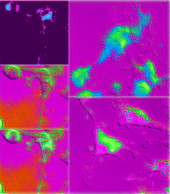Highlight
Microbial Research Advances Bioterrorism Preparedness
Achievement/Results
The bacterium Burkholderia pseudomallei is endemic to Southeast Asia and Northern Australia and causes a serious disease known as melioidosis. Melioidosis is extremely infectious when acquired by the aerosol route and without antibiotic treatment is often fatal for animals and humans. For these reasons B. pseudomallei has been deemed a select agent by the USDA and CDC. The Bioterrorism Preparedness Act of 2001 placed utmost importance in the availability and development of countermeasures, such as vaccines, to those microorganisms classified as select-agents. We engineered strains with the aim of further development into vaccine candidates. During the past few years, IGERT faculty and Trainee Michael Norris collaborated with geneticists and veterinarians at Colorado State University in the first round of efficacy testing. Tests confirmed the non-pathogenic nature of our strains and experimental vaccination demonstrated protection against disease caused by inhaling this dangerous microorganism.
The aim of the research is to improve biosecurity by providing scientists with the tools necessary to better understand the diseases potentially threatening our nation. Whether these be genetic tools that provide safe alternatives to unfavorable methodologies of the past or new methodologies that could greatly increase the knowledge of the disease. The research is novel in that it provides a foundation for numerous scientists in the field to build on; one cannot build a building unless the ground it stands on is solid.
The tools developed have allowed the safe genetic manipulation of the bacterium whereby no drug resistance is introduced and the same end attained. Another development is the generation of optical tagging tools for the bacterium. In order to easily study the cellular processes by which this bacterium causes disease one must be able to follow the bacterium. In larger animals a tracking device is used, in bacterium they must be tagged so they may be visible under a microscope. Fluorescent tags were developed that have optimal use with the bacterium B. pseudomallei. Now it has become quite simple to track the bacterium though the infectious process. This can provide great insight into how the disease is caused and thus how to prevent it.
Yet another aspect of the research was to help develop methodologies for understanding how the bacterium responds to the host. This is done by global gene expression profiling of the bacterium during the infection, which paints a picture of what genes are turned by the bacterium during an infection. At present, methodologies focus on a pool of bacterium. This can cause discrepancies when you are trying to identify genes important for a very specific infectious stage, such as; what genes are turned on when the bacterium is entering a host cell? If you look at a pool of bacterium they are all probably at different stages of the infectious cycle, some will be entering the host cell and others will be replicating inside the host cell, and yet others will be exiting. The outcome would be an average of all the processes and all details concerning the precise infectious stages would be lost. This research aided in the discovery and patenting of a new methodology that allows the global gene analysis of a single bacterium. As the first methodology of its kind it can be applied to any microorganism and is in great demand from companies and colleagues alike.
Combining the fluorescent tagging, described above, with this new methodology has provided a clear picture of what B. pseudomallei is doing at the precise infectious stages. Using this technique the research has identified 11 hypothetical proteins necessary for the infectious process and may be potential drug targets or vaccine candidates.
Address Goals
This project provided a unique integrative research opportunity. It combined the knowledge of leading researchers in microbiology and genetic engineer, along with cutting edge laboratory research technologies. Not only has this yielded new research methods and tools, it opens up a new avenue for research on a pathogen of significant medical and biosecurity significance. The project involved the collaboration of a large group of researchers, graduate students, exposing all of them to new ideas, ways of thinking about and approaching microbial pathogen research, while developing new research skills.






